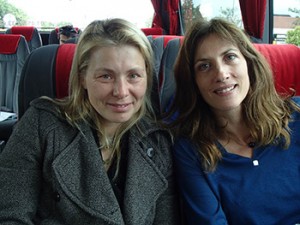Artist Interview: Traveling with Théâtre de la Ville
Editor’s note: This summer, UMS launched a new 21st Century Artist Internships program. Four students interned for a minimum of five weeks with a dance, theater, or music ensemble part of our 2014-2015 season. Héctor Flores Komatsu is one of these students. He spent five weeks with Théâtre de la Ville in Paris, France.
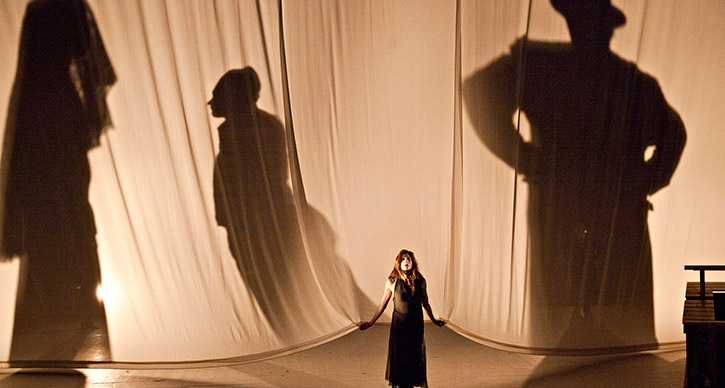
Théâtre de la Ville performs Six Characters in Search of An Author at the Power Center in Ann Arbor on October 24-25, 2014. Photo by JL Fernandez.
Scene
13:30, May 23, 2014, Paris, France. En route to final dress rehearsals of Six Characters in Search of an Author at Le Forum Blanc Mesnil, a banlieu (suburb) located at the northern outskirts of the city proper. Cast and production members sit throughout the van shuttle between Théâtre de la Ville and our current rehearsal space.
Les mecs (the dudes) hang out in the back, and one of their phones alternates between the American and French pop hits of the moment. Some nap, some read, some eat their lunch. They converse in the relaxed, soft, yet gutturally vibrant and “chic” French that had initially been both inviting and intimidating to my Mexican-American mélange of an accent.
Actress Sarah Karbasnikoff’s sweet, edgy, yet motherly voice, proper for her character, rises in joyous laughter, while actress Valerie Dashwood’s dark, yet subdued, cedar timbre seduces the air with chuckles, not unlike those heard from her character, the Step-Daughter. The laughter is inviting, I sit across them, speaking in “tu,” not “vous,” as they had requested.
We chat for the readers in Ann Arbor, of which Sarah has fond memories with Rhinos stampeding through the fallen autumn foliage. (Théâtre de la Ville last visited Ann Arbor to perform Ionesco’s Rhinocéros in 2012.)
Héctor Flores Komatsu: You are a very interesting mother-daughter stage pair! Could you talk a bit about your characters’ relationship in the show?
Sarah Karbasnikoff: Well, I play the Mother, who… Let’s just say she suddenly arrives at the theater with her first husband and all of her children.
HFK: Hmm…
Sarah: Ha! That’s what you need to know, I don’t think I should say more!
[Laughter]
Valerie Dashwood: As for me, I play the “Step-Daughter.” She is such because her mother…
Sarah: That’s me…
Valerie: Was initially married to the character of the Father, with whom she had…
Sarah: A boy.
Valerie: Yes, a boy… Just one boy.
Sarah: Voila!
Valerie: Afterwards, she “had” a second man, my true father, with whom she had three children of which I play the eldest, the Daughter.
HFK: What would you then say is the fundamental need, desire, of the mother, of the Step-Daughter, of the family as a whole? What is it? Is it love? Is it to unite the entire family? Is there a common desire as a family?
Sarah: Well, that will certainly differ for each character.
Valerie: For the Step-Daughter there’s no need or desire to be part the family. One of the first things she says is that she “will take off – fly away!” because she doesn’t want to be part of it.
Deep inside, she detests her Step-father, and she also hates his first, legitimate, son. She speaks a lot about legitimacy, because perhaps she doesn’t feel entirely legitimate. She doesn’t have legitimacy even within society, given that she’s had to prostitute herself to support her mother and siblings. That’s her point of view.
Her desire is, more than anything, is to self-destruct, through which she can emancipate herself from her family, become and adult.
HFK: She fights for her freedom!
Valerie: She fights for her freedom!
HFK: For the mother it seems to be quite the opposite.
Sarah: Each day I discover her a little more. At this moment I have the impression that, yes, she seeks to see her son again, that is certain, because she wasn’t there for him, and so there’s some degree of guilt. Her two youngest children die, and eldest daughter wishes to escape from her. So yes, her greatest desire is to bring everyone together but, alas, that’s impossible. Her life is her children, all of whom escape from her, leave her.
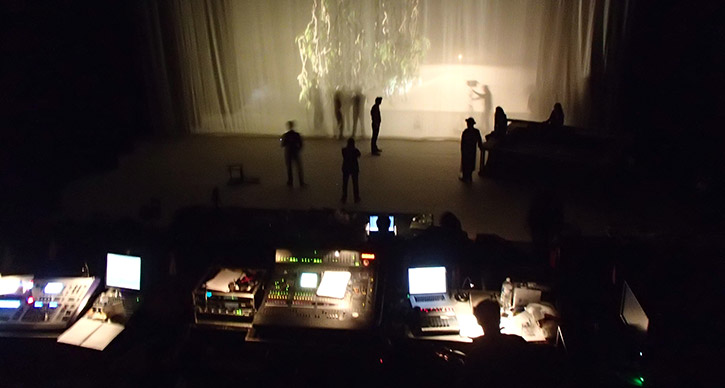
During rehearsal with Théâtre de la Ville. Photo by Héctor Flores Komatsu.
HFK: How has the process been for you, as a new actress in this restaging, stepping into a role originated by someone else?
Sarah: Well, first one must do what’s already been done and understand what already exists. I’ve been stepping into the shoes of the original actress.
And now, with each run, I begin to understand the reason behind her movements, the psychological motivations. At first they were mere just movements, crossing from one place to another, and I simply memorized them; it was very concrete, very technical work. And then, from that point, I began to create the character.
HFK: For you Valerie, having played this role in the original production twelve years ago, what has it been like this time? What has been unearthed once more? What has been newly discovered?
Valerie: What’s been really interesting for me, since it’s been twelve years since I played this role in the original production, is that upon returning to this play, I could not perfectly recall many specifics, but I still had a global feeling of the character, the violence, the pain, and of the will – that’s what it is! The will of the character, is what I remembered well.
However, I could barely remember the text – except for the song! Bizarrely, that had completely stayed with me; I remembered the song… but not my lines!
But then when we read out the play all together at Théâtre de la Ville, with Hugues [Quester, who plays the Father] and Alain [Libolt, who plays the Director], hearing their voices and feeling their energies through the text, the memory came back to me. By reading with them, I was surprised to feel the same emotions from years ago resurface, as if something which long laid dormant suddenly awoke, opening itself. Voila!
After that, relearning the text was very easy.
HFK: What is different today, than how it was twelve years ago?
Valerie: The biggest difference is that twelve years ago I didn’t have children, and now I’ve had two. So my maternal instinct, the one my character has for her little sister, feels very different. Motherhood has hit me hard, and it affects how I act, even in the way I look at the little girl. Sans resorting to any psychological tricks, I instinctively see my daughter in the little girl. I have a child now… And that fact greatly affects how I act, knowing that this little girl, in the play, will die.
I don’t think I could ever do this in the same way as I did twelve years go.
Also, having worked so much in just the past ten years, I feel much more physically available in my own body, much more reserved. At the time, the nudity had originally been somewhat difficult for me, but much less so nowadays. That scene, which I came to fear, I now approach with serenity, even when it’s hard to play.
HFK: And now for my last question for you. I’ve noticed that there’s a lot of love and care behind the scenes among the cast. And for you two, who play Mother and Daughter on stage but are much closer in friendship and in age off-stage, how does that affect your stage relationship?
Valerie: All I can say is… Just like in our previous play, I played the mother to Sandra [another Théâtre de la Ville actress who also plays one of the “actresses” in Six Characters]. I never feel the need to ask myself whether this is or isn’t “coherent,” even if we are only twelve years apart. In theatre, we have what we call, at least in French, a “convention” to suspend disbelief. So right now, Sarah may be playing my mother, and we understand each other really well, which is good because playing this relationship requires great emotional investment. We can support that off-stage. Our closeness strengthens the bond vital to plunging into the work together.
Sarah: For me it’s very similar. During the show I don’t think at all about the age difference. To feel Valerie as she plays her character, I do nothing more than to say “she’s my daughter.” That’s it, I don’t see the age at all. There’s also an understanding of our respective pains, because we know each other personally. That really gets me, it truly does. She does, her pain. She might not truly be her character, but we form an affinity, a bond.
We streamline into casual conversation, and soon enough arrive at the theater. An hour into the rehearsal, as everybody gets into costume and warms into their roles Valerie receives a phone call. Her youngest child isn’t feeling well. She ponders the symptoms, trying to figure the right remedy. There’s the natural concern of the working actress-mother in the midst of rehearsals. She seeks her stage-mother Sarah, a veteran mother in various senses, for reassurance. That’ll do it,” Sarah says. For a moment, the parallel lines of reality and fiction intersect, not unlike in the play, as the two women connect through maternity.
Interested in more? Look for Flores’s behind-the-scenes photo-essay covering his time with the company.
Student Spotlight: Summer with Théâtre de la Ville
As part of the 21st Century Artist Internships program, U-M students spend several weeks working with companies that are part of the UMS season. In 2014, 21st century student Héctor Flores Komatsu worked with Théâtre de la Ville in Paris, France.
Below, Flores shares his travel stories with the company. Théâtre de la Ville returns to Ann Arbor with L’État de siege (State of Siege) on October 13-14, 2017.
El Espíritu Oculto de la Olvidada Europa
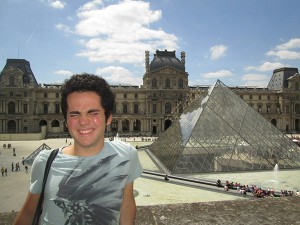
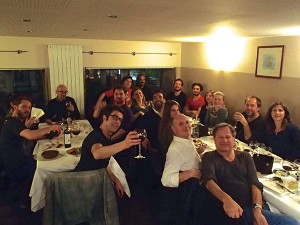
Photos: On the left, Flores in Paris. On the right, the company during dinner. All photos by Flores Komatsu.
The word “summer” has always had a very homey and rooted connotation to me. Road or plane trips that traverse borders were a staple of my upbringing. I’d look forward to the summers of eternal spring in my Mexican hometown, under the shade of the oscillating bugambilias, tantalized by the scent of Sunday morning house-spiced chorizo at my grandfather’s. If I owe my curiosity and affinity for the intercultural richness of the world to anything, it’s to the very familiar act of crossing borders.
I finally had the opportunity to venture away from the continent this summer, after Jim Leija [UMS Director of Education & Community Engagement] called to invite me to intern for UMS in Paris as part of the new 21st Century Artist Internship. I’d be leaving for France in three weeks.
And so, I took-off to Europe to intern with Théâtre de la Ville, Paris’s cultural institution for the performing arts (as well as an Ann Arbor and UMS favorite, having performed Ionesco’s Rhinocéros at the Power Center two seasons ago). I’d be working as a rehearsal assistant and media collector for their upcoming touring production of Six Characters in Search of an Author (to be performed at the Power Center October 24-25, 2014). All this presented itself, serendipitously, a mere two weeks before the end of my sophomore year at the University of Michigan — truly, an open door. Little did I know that, thanks to continuing serendipity, I wouldn’t set foot back in Ann Arbor until a few days before this Fall term.
Within minutes of boarding that plane, I instinctively felt that I was about to experience the most gratifying, unsettling, and enriching journey of my short years. It became a summer that has helped me to unearth my roots and left me with a hunger that’s been eating me alive, yet thankfully not eating me dead. I hope I can awaken a similar appetite in readers of this blog with my anecdotes from my time with Théâtre de la Ville (TDLV) and my first journey into the Old World.
Un Jeu des Rôles au Théâtre de la Ville
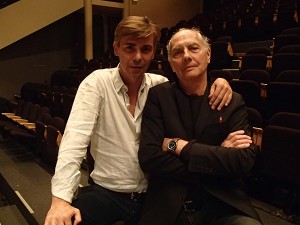
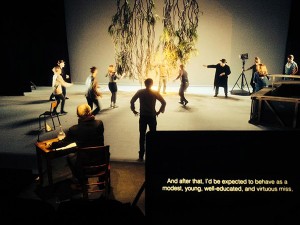
Photos: On the left, the two directors: Théâtre de la Ville director Emmanuel Demarcy-Mota and actor Alain Libolt, who plays the role of “Director” in Six Characters in Search of An Author. On the right, rehearsal with sub-titles.
Casually crossing the Pont Neuf on the Seine on the way to my first day, checking-out Notre Dame from the smoker’s balcony (though I don’t smoke), and then finishing my paperwork as the sun set against the Eiffel Tower seemed either the best cliché or too surreal to be true; but it was true, beauty on every corner. However, this type of initial beauty can grow stale with habit, and I quickly found beauty in the fondness my companions as well.
This type of beauty emerged when sharing a simple picnic with the company by the river at lunch, for example. I think the the vitality of a company originates from the unified pulse of its ensemble, that pulse that is universal in any theater venture, regardless of country. Sure, “stage-right” in French might be “the garden” (you can imagine the confusion for me, given that there’s an actual garden in the production). Sure, there may not be such a thing as blocking notes for re-stagings. And maybe the reasons for doing theater at all are very different. Still, the collaborative nature of theater is undeniable across the globe.
Six Characters in Search of an Author is play in which the dramatic truth is juxtaposed with immediate reality. Actors play actors, for example, while directors coach actors to play directors. The lines between performance and reality are crossed. For me, the ideas were constantly in translation as well. Yours truly was tasked with sub-titling the originally Italian text of the play (which is performed in French) into English. Ultimately, the goal for everyone involved, the director, the ensemble, and myself, was the same: To connect the inner life of the play to the outer life of the audience.
La culture ne marche pas!
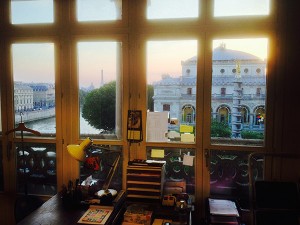
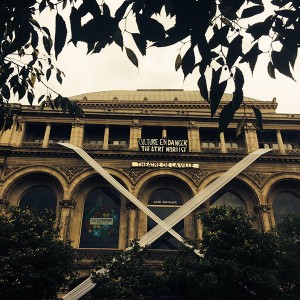
Photos: On left, sunset as viewed from the theater. On right, the theater, “X”-ed.
I spent two weeks in Italy (turns out speaking Spanish with an Italian inflection doesn’t actually mean you can speak Italian), and upon my return to Paris, I found culture in distress. “Culture,” substantially subsidized by the government and also supported by patrons, was immobilized and in peril due to some impending changes. To put it simply, recent overhauls to labor laws were to compromise the financial security, primarily through alterations to unemployment benefits, of “gypsy” professionals (including actors and stage hands), changing a system which (although not without faults) had long kept the performing arts alive, thriving, and, more importantly, relevant to the society.
The strongest impact on Théâtre de la Ville occurred during its annual city-wide performing arts festival Chantiers d’Europe. The festival saw various performances, all brought from abroad, cancelled as theater venues around the city shut down as part of a strike. TDLV, however remained strong. I learned perhaps my biggest lesson from [Théâtre de la Ville director] Emmanuel Demarcy-Mota when I saw him rally and inspire the company to, instead of shutting down the power of the stage at this time of turmoil, take advantage of the theater’s influence on the city and its audiences. In July, the façade of the theater was crossed with a large white “X” of defiance.
In the midst of the strikes came the opening night for a sold-out run of Pina Bausch – Wuppertal Tanztheatre, a yearly visitor and old friend of TDLV. The company was to perform the “wall”-breaking (both literally and figuratively) Palermo, Palermo. Dramatic truth came from an unexpected place in the bravest and most honest theatrical moment I got to witnessed in France.
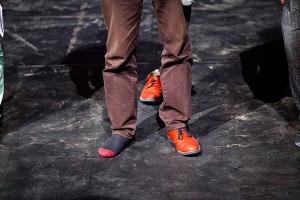
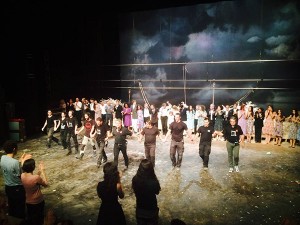
Photos: On left, Michael Chase. On right, company and stagehands bow together.
The co-head of the theater, Michael Chase, a reserved man of soft-spoken, tactful, iron words stood center-stage along his company in front of a full house. He softly said that without the workers of the theater, “La culture ne marche pas.” He bent down towards his signature red shoes, untied and removed one of them. He took a step forward as the rest of the company followed his actions.
Later, at the end of the performance, the dancers invited the stagehands, who had built for them, everyday, a brick wall that spanned the proscenium arch, and which tumbled and consequently needed rearranging by the stagehands mid-performance in plain view of the audience, to the stage. They joined the dancers. Everyone took a bow, every single one of them an artist without which “culture wouldn’t move”. And then the curtain fell.
Updated 6/2/2017.


